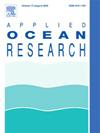Wave heights over Canadian oceans: Tempo-spatial variations and climate-oscillation impacts based on macroscale spatially-extrapolative retrieval from altimetric ensembles
IF 4.3
2区 工程技术
Q1 ENGINEERING, OCEAN
引用次数: 0
Abstract
Estimation and analyses of significant wave heights (SWHs) are crucial to climate research, ocean engineering and other applications, with satellite retrieval serving as a fundamental approach. However, few studies attempt to extrapolate SWH models across buoy grids to retrieve ungauged-grid SWHs from multiple altimeters at macroscales, or examine variations of extreme SWHs in relation to climate oscillations, particularly in the Canadian context. To fill these gaps, we develop a macroscale spatially-extrapolative ensemble wave-height retrieval and analysis (MEERA) method to retrieve SWHs from multi-mission satellite altimetry and reveal tempo-spatial characteristics of SWHs means and extremes as well as their variations with climate oscillations. The method is applied across all Canadian waters. According to modeling results, MEERA significantly enhances consistency and accuracy of retrieved SWHs (especially in coastal areas), e.g., reducing biases of conventional methods by over 98%. From 1985 to 2020, waves were strongly seasonal and regional, which drop from winter (1.45 m) to summer (1.17 m) and tend to decline northward. SWHs tend to decrease in mid-eastern regions (e.g., Hudson Bay, Davis Strait and Gulf of St Lawrence) and increase in Canadian Atlantic, Pacific, and Arctic. Across all Canadian waters, climate indices regarding precipitation, e.g., the NBRA (Northeast Brazil Rainfall Anomaly) index, pose the strongest impacts on extreme SWHs compared with others. In Pacific and Atlantic, spatial patterns of winter SWH extremes are associated with negative NAO (North Atlantic Oscillation). El Niño might increase SWHs extremes over the Pacific and Arctic, while decreasing them over mid-eastern regions. This study advances macroscale SWH estimation and analysis, enhancing the understanding of SWH characteristics and their variations across Canada under climate change.
加拿大海洋上的波高:基于高程集合的大尺度空间外推反演的时空变化和气候振荡影响
有效波高(SWHs)的估算和分析对于气候研究、海洋工程和其他应用至关重要,卫星反演是一种基本方法。然而,很少有研究尝试跨浮标网格外推SWH模型,以从多个高度计在宏观尺度上检索未测量网格的SWHs,或者检查极端SWHs的变化与气候振荡的关系,特别是在加拿大的背景下。为了填补这些空白,我们开发了一种大尺度空间外推集合波高检索与分析(MEERA)方法,从多任务卫星测高数据中检索海波高,揭示海波高均值和极值的时空特征及其随气候振荡的变化。该方法适用于加拿大所有水域。根据建模结果,MEERA显著提高了SWHs反演的一致性和准确性(特别是在沿海地区),例如将传统方法的偏差降低了98%以上。1985 - 2020年,波浪具有强烈的季节性和区域性,从冬季(1.45 m)下降到夏季(1.17 m),并有向北下降的趋势。中东部地区(如哈德逊湾、戴维斯海峡和圣劳伦斯湾)的SWHs有减少的趋势,而加拿大大西洋、太平洋和北极的SWHs则有增加的趋势。在所有加拿大水域,与降水有关的气候指数,如NBRA(巴西东北降水异常)指数,对极端SWHs的影响最大。在太平洋和大西洋,冬季SWH极值的空间格局与负的NAO(北大西洋涛动)有关。El Niño可能会增加太平洋和北极的极端海温,而减少中东地区的极端海温。本研究推进了宏观尺度的SWH估算和分析,增强了对气候变化下加拿大SWH特征及其变化的认识。
本文章由计算机程序翻译,如有差异,请以英文原文为准。
求助全文
约1分钟内获得全文
求助全文
来源期刊

Applied Ocean Research
地学-工程:大洋
CiteScore
8.70
自引率
7.00%
发文量
316
审稿时长
59 days
期刊介绍:
The aim of Applied Ocean Research is to encourage the submission of papers that advance the state of knowledge in a range of topics relevant to ocean engineering.
 求助内容:
求助内容: 应助结果提醒方式:
应助结果提醒方式:


